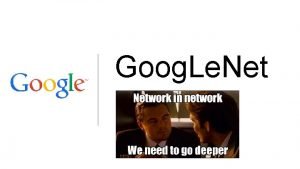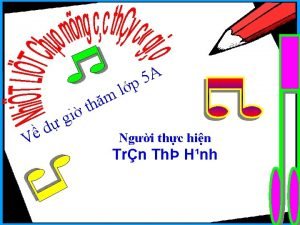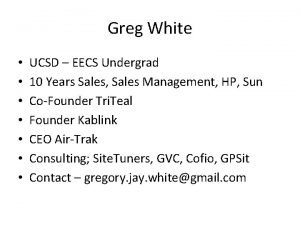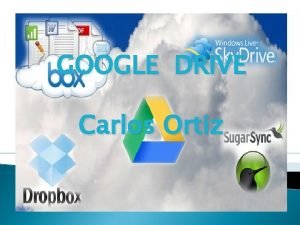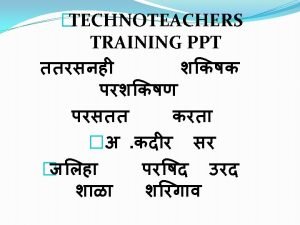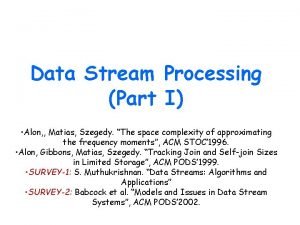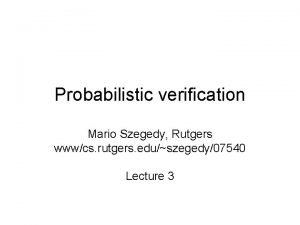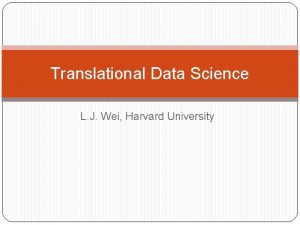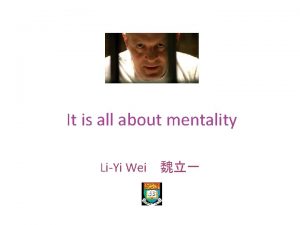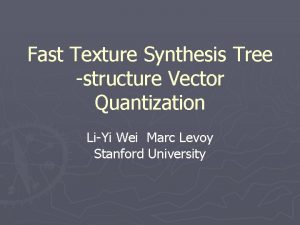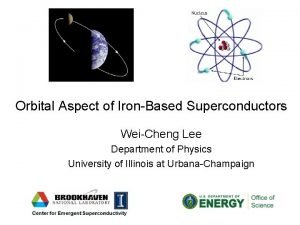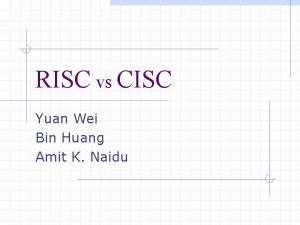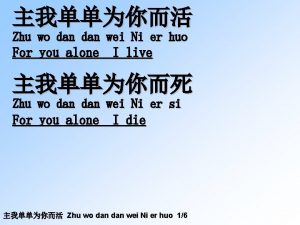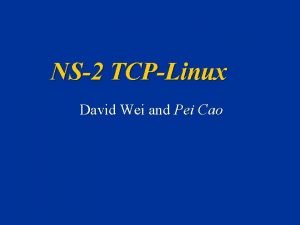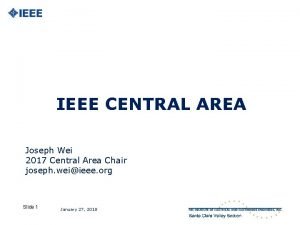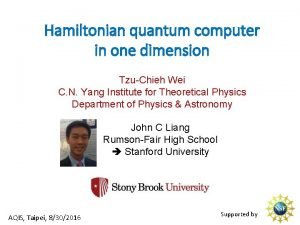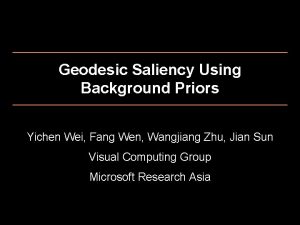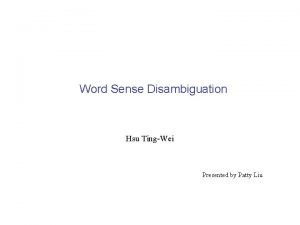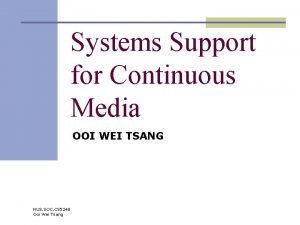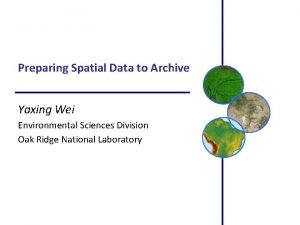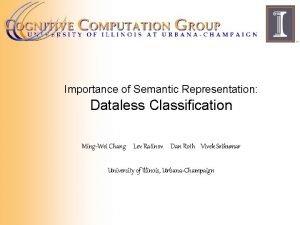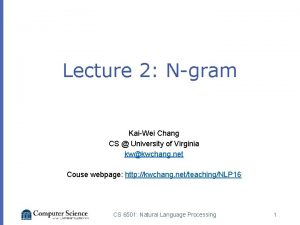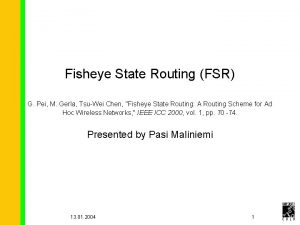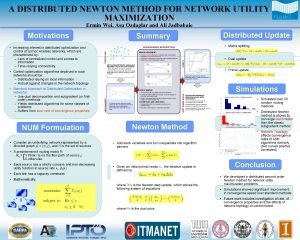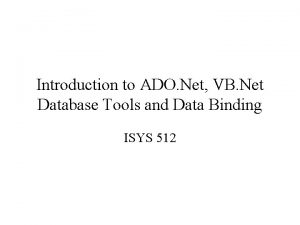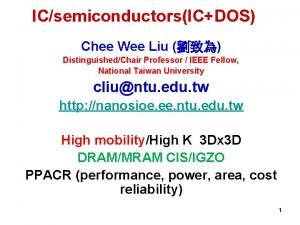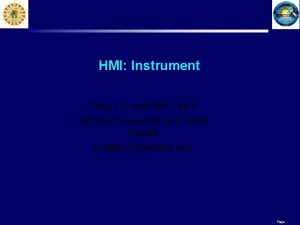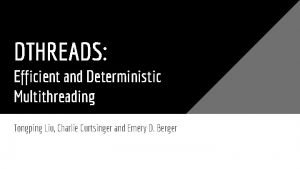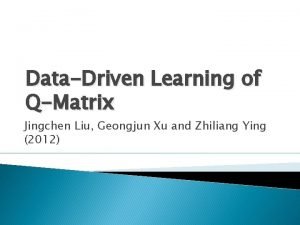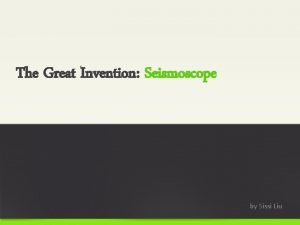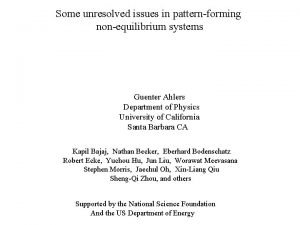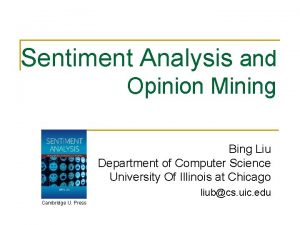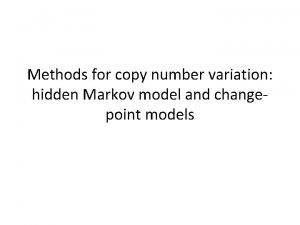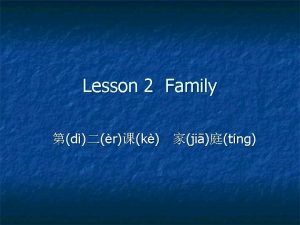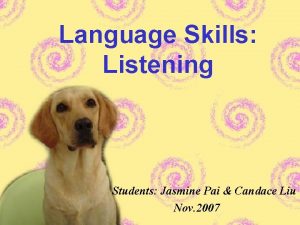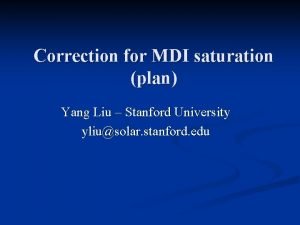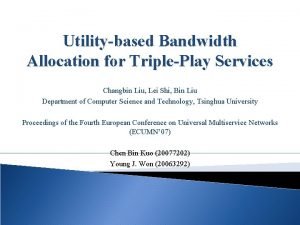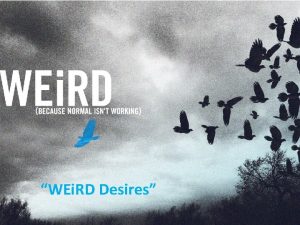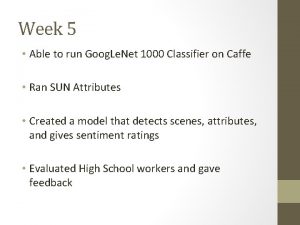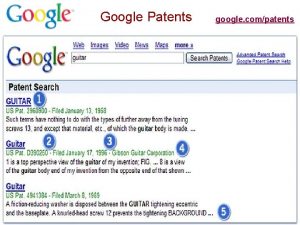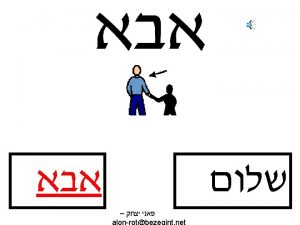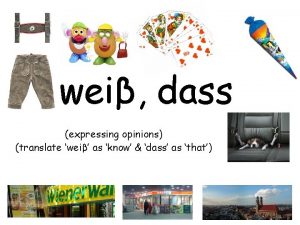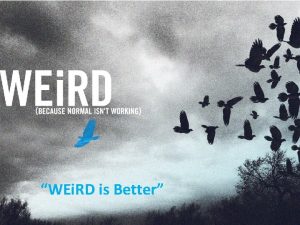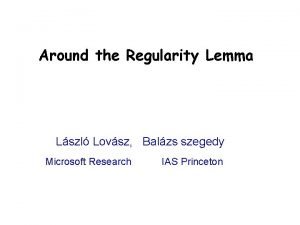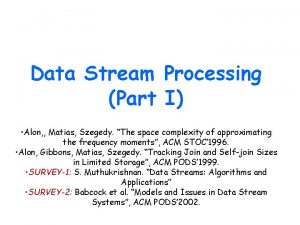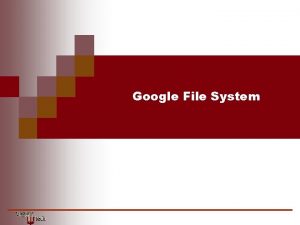Goog Le Net Christian Szegedy Wei Liu Google








































































- Slides: 72

Goog. Le. Net

Christian Szegedy, Wei Liu, Google UNC Yangqing Jia, Pierre Sermanet, Scott Reed, Dragomir Anguelov, Google University of Michigan Dumitru Erhan, Google Vincent Vanhoucke, Google Andrew Rabinovich, Google

Deep Convolutional Networks Revolutionizing computer vision since 1989


Deep Convolutional Networks 2012 Revolutionizing computer vision since 1989

Why is the deep learning revolution arriving just now?

Why is the deep learning revolution arriving just now? ● Deep learning needs a lot of training data.

Why is the deep learning revolution arriving just now? ● Deep learning needs a lot of training data. ● Deep learning needs a lot of computational resources

Why is the deep learning revolution arriving just now? ● Deep learning needs a lot of training data. ● Deep learning needs a lot of computational resources

Why is the deep learning revolution arriving just now? ● Deep learning needs a lot of training data. ● Deep learning needs a lot of computational resources ?

Why is the deep learning revolution arriving just now? ● Deep learning needs a lot of training data. ● Deep learning needs a lot of computational resources Szegedy, C. , Toshev, A. , & Erhan, D. (2013). Deep neural networks for object detection. In Advances in Neural Information Processing Systems 2013 (pp. 2553 -2561). Then state of the art performance using a training set of ~10 K images for object detection on 20 classes of VOC, without pretraining on Image. Net.

Why is the deep learning revolution arriving just now? ● Deep learning needs a lot of training data. ● Deep learning needs a lot of computational resources Agarwal, P. , Girshick, R. , & Malik, J. (2014). Analyzing the Performance of Multilayer Neural Networks for Object Recognition http: //arxiv. org/pdf/1407. 1610 v 1. pdf 40% m. AP on Pascal VOC 2007 only without pretraining on Image. Net.

Why is the deep learning revolution arriving just now? Toshev, A. , & Szegedy, C. ● Deep learning needs a lot of training data. ● Deep learning needs a lot of computational resources Deeppose: Human pose estimation via deep neural networks. CVPR 2014 Setting the state of the art of human pose estimation on LSP by training CNN on four thousand images from scratch.

Why is the deep learning revolution arriving just now? ● Deep learning needs a lot of training data. ● Deep learning needs a lot of computational resources

Why is the deep learning revolution arriving just now? ● Deep learning needs a lot of training data. ● Deep learning needs a lot of computational resources Erhan, D. , Szegedy, C. , Toshev, A. , & Anguelov, D. Scalable Object Detection using Deep Neural Networks. CVPR 2014 Significantly faster to evaluate than typical (non-specialized) DPM implementation, even for a single object category.

Why is the deep learning revolution arriving just now? ● Deep learning needs a lot of training data. Large scale distributed multigrid solvers since the 1990 ies. ● Deep learning needs a lot of computational resources Map. Reduce since 2004 (Jeff Dean et al. ) Scientific computing is dedicated to solving large scale complex numerical problems for decades on scale via distributed systems.

UFLDL (2010) on Deep Learning “While theoretical benefits of deep networks in terms of their compactness and expressive power have been appreciated for many decades, until recently researchers had little success training deep architectures. ” … snip … “How can we train a deep network? One method that has seen some success is the greedy layerwise training method. ” … snip … “Training can either be supervised (say, with classification error as the objective function on each step), but more frequently it is unsupervised “ Andrew Ng, UFLDL tutorial

Why is the deep learning revolution arriving just now? ● Deep learning needs a lot of training data. ● Deep learning needs a lot of computational resources ? ? ?

Why is the deep learning revolution arriving just now?

Why is the deep learning revolution arriving just now?

Why is the deep learning revolution arriving just now? Rectified Linear Unit Glorot, X. , Bordes, A. , & Bengio, Y. (2011). Deep sparse rectifier networks In Proceedings of the 14 th International Conference on Artificial Intelligence and Statistics. JMLR W&CP Volume (Vol. 15, pp. 315 -323).

Goog. Le. Net Convolution Pooling Softmax Other

Goog. Le. Net vs State of the art Goog. Le. Net Convolution Pooling Softmax Other Zeiler-Fergus Architecture (1 tower)

Problems with training deep architectures? Vanishing gradient? Exploding gradient? Tricky weight initialization?

Problems with training deep architectures? Vanishing gradient? Exploding gradient? Tricky weight initialization?

Justified Questions Why does it have so many layers? ? ?

Justified Questions Why does it have so many layers? ? ?

Why is the deep learning revolution arriving just now? ● It used to be hard and cumbersome to train deep models due to sigmoid nonlinearities.

Why is the deep learning revolution arriving just now? ● It used to be hard and cumbersome to train deep models due to sigmoid nonlinearities. ● Deep neural networks are highly non-convex without any obvious optimality guarantees or nice theory.

Why is the deep learning revolution arriving just now? U L ● It used to be hard and cumbersome to train deep models due to sigmoid nonlinearities. e R ● Deep neural networks are highly non-convex without any optimality guarantees or nice theory. ?

Theoretical breakthroughs Arora, S. , Bhaskara, A. , Ge, R. , & Ma, T. Provable bounds for learning some deep representations. ICML 2014

Theoretical breakthroughs Arora, S. , Bhaskara, A. , Ge, R. , & Ma, T. Provable bounds for learning some deep representations. ! s e n o x ICML 2014 nve o n e v E -c n o n

Hebbian Principle Input

Cluster according activation statistics Layer 1 Input

Cluster according correlation statistics Layer 2 Layer 1 Input

Cluster according correlation statistics Layer 3 Layer 2 Layer 1 Input

In images, correlations tend to be local

Cover very local clusters by 1 x 1 convolutions number of filters 1 x 1

Less spread out correlations number of filters 1 x 1

Cover more spread out clusters by 3 x 3 convolutions number of filters 1 x 1 3 x 3

Cover more spread out clusters by 5 x 5 convolutions number of filters 1 x 1 3 x 3

Cover more spread out clusters by 5 x 5 convolutions number of filters 1 x 1 3 x 3 5 x 5

A heterogeneous set of convolutions number of filters 1 x 1 3 x 3 5 x 5

Schematic view (naive version) number of filters 1 x 1 Filter concatenation 3 x 3 1 x 1 convolutions 3 x 3 convolutions 5 x 5 Previous layer 5 x 5 convolutions

Naive idea Filter concatenation 1 x 1 convolutions 3 x 3 convolutions Previous layer 5 x 5 convolutions

Naive idea (does not work!) Filter concatenation 1 x 1 convolutions 3 x 3 convolutions Previous layer 5 x 5 convolutions 3 x 3 max pooling

Inception module Filter concatenation 3 x 3 convolutions 5 x 5 convolutions 1 x 1 convolutions 3 x 3 max pooling 1 x 1 convolutions Previous layer

Inception Why does it have so many layers? ? ? Convolution Pooling Softmax Other

Inception 9 Inception modules Network in a network. . . Convolution Pooling Softmax Other

Inception 256 512 480 512 832 1024 480 Width of inception modules ranges from 256 filters (in early modules) to 1024 in top inception modules.

Inception 256 512 480 512 832 1024 480 Width of inception modules ranges from 256 filters (in early modules) to 1024 in top inception modules. Can remove fully connected layers on top completely

Inception 256 512 480 512 832 1024 480 Width of inception modules ranges from 256 filters (in early modules) to 1024 in top inception modules. Can remove fully connected layers on top completely Number of parameters is reduced to 5 million

Inception 256 512 480 512 832 1024 480 Width of inception modules ranges from 256 filters (in early modules) to 1024 in top inception modules. Can remove fully connected layers on top completely Number of parameters is reduced to 5 million Computional cost is increased by less than 2 X compared to Krizhevsky’s network. (<1. 5 Bn operations/evaluation)

Classification results on Image. Net 2012 Number of Models Number of Crops Computational Cost Top-5 Error Compared to Base 1 1 (center crop) 1 x 10. 07% - 1 10* 10 x 9. 15% -0. 92% 1 144 (Our approach) 144 x 7. 89% -2. 18% 7 1 (center crop) 7 x 8. 09% -1. 98% 7 10* 70 x 7. 62% -2. 45% 7 144 (Our approach) 1008 x 6. 67% -3. 41% *Cropping by [Krizhevsky et al 2014]

Classification results on Image. Net 2012 Number of Models Number of Crops Computational Cost Top-5 Error Compared to Base 1 1 (center crop) 1 x 10. 07% - 1 10* 10 x 9. 15% -0. 92% 1 144 (Our approach) 144 x 7. 89% -2. 18% 7 1 (center crop) 7 x 8. 09% -1. 98% 7 10* 70 x 7. 62% -2. 45% 7 144 (Our approach) 1008 x 6. 67% -3. 41% 6. 54% *Cropping by [Krizhevsky et al 2014]

Classification results on Image. Net 2012 Team Year Place Error (top-5) Uses external data Super. Vision 2012 - 16. 4% no Super. Vision 2012 1 st 15. 3% Image. Net 22 k Clarifai 2013 - 11. 7% no Clarifai 2013 1 st 11. 2% Image. Net 22 k MSRA 2014 3 rd 7. 35% no VGG 2014 2 nd 7. 32% no Goog. Le. Net 2014 1 st 6. 67% no

Detection ● Girshick, R. , Donahue, J. , Darrell, T. , & Malik, J. (2013). Rich feature hierarchies for accurate object detection and semantic segmentation. ar. Xiv preprint ar. Xiv: 1311. 2524.

Detection ● Girshick, R. , Donahue, J. , Darrell, T. , & Malik, J. (2013). Rich feature hierarchies for accurate object detection and semantic segmentation. ar. Xiv preprint ar. Xiv: 1311. 2524. ● Improved proposal generation: ○ Increase size of super-pixels by 2 X ■ coverage 92% 90% ■ number of proposals: 2000/image 1000/image

Detection ● Girshick, R. , Donahue, J. , Darrell, T. , & Malik, J. (2013). Rich feature hierarchies for accurate object detection and semantic segmentation. ar. Xiv preprint ar. Xiv: 1311. 2524. ● Improved proposal generation: ○ Increase size of super-pixels by 2 X ■ coverage 92% 90% ■ number of proposals: 2000/image 1000/image ○ Add multibox* proposals ■ coverage 90% 93% ■ number of proposals: 1000/image 1200/image *Erhan, D. , Szegedy, C. , Toshev, A. , & Anguelov, D. Scalable Object Detection using Deep Neural Networks. CVPR 2014

Detection ● Girshick, R. , Donahue, J. , Darrell, T. , & Malik, J. (2013). Rich feature hierarchies for accurate object detection and semantic segmentation. ar. Xiv preprint ar. Xiv: 1311. 2524. ● Improved proposal generation: ○ Increase size of super-pixels by 2 X ■ coverage 92% 90% ■ number of proposals: 2000/image 1000/image ○ Add multibox* proposals ■ coverage 90% 93% ■ number of proposals: 1000/image 1200/image ○ Improves m. AP by about 1% for single model. *Erhan, D. , Szegedy, C. , Toshev, A. , & Anguelov, D. Scalable Object Detection using Deep Neural Networks. CVPR 2014

Detection results without ensembling Team m. AP external data contextual model bounding-box regression Trimps-Soushen 31. 6% ILSVRC 12 Classification no ? Berkeley Vision 34. 5% ILSVRC 12 Classification no yes Uv. A-Euvision 35. 4% ILSVRC 12 Classification ? ? CUHK Deep. ID-Net 2 37. 7% ILSVRC 12 Classification+ Localization no ? Goog. Le. Net 38. 0% ILSVRC 12 Classification no no Deep Insight 40. 2% ILSVRC 12 Classification yes

Final Detection Results Team Year Place m. AP external data ensemble contextual model approach Uv. A-Euvision 2013 1 st 22. 6% none ? yes Fisher vectors Deep Insight 2014 3 rd 40. 5% ILSVRC 12 Classification + Localization 3 models yes Conv. Net CUHK Deep. ID-Net 2014 2 nd 40. 7% ILSVRC 12 Classification + Localization ? no Conv. Net Goog. Le. Net 2014 1 st 43. 9% ILSVRC 12 Classification 6 models no Conv. Net

Classification failure cases Groundtruth: ? ?

Classification failure cases Groundtruth: coffee mug

Classification failure cases Groundtruth: coffee mug Goog. Le. Net: ● ● ● table lamp shade printer projector desktop computer

Classification failure cases Groundtruth: ? ? ?

Classification failure cases Groundtruth: Police car

Classification failure cases Groundtruth: Police car Goog. Le. Net: ● ● ● laptop hair drier binocular ATM machine seat belt

Classification failure cases Groundtruth: ? ? ?

Classification failure cases Groundtruth: hay

Classification failure cases Groundtruth: hay Goog. Le. Net: ● sorrel (horse) ● hartebeest ● Arabian camel ● warthog ● gaselle

Acknowledgments We would like to thank: Chuck Rosenberg, Hartwig Adam, Alex Toshev, Tom Duerig, Ning Ye, Rajat Monga, Jon Shlens, Alex Krizhevsky, Sudheendra Vijayanarasimhan, Jeff Dean, Ilya Sutskever, … and check out our poster! Andrea Frome
 Christian szegedy
Christian szegedy Alex liu cecilia liu
Alex liu cecilia liu Líu líu lo lo ta ca hát say sưa
Líu líu lo lo ta ca hát say sưa System design architecture
System design architecture Goog;e
Goog;e Ucsd eecs
Ucsd eecs Goog elmaps
Goog elmaps Gmailgmailgmailgmail
Gmailgmailgmailgmail Alon matias szegedy
Alon matias szegedy Mario szegedy
Mario szegedy Netalex
Netalex Lj wei harvard
Lj wei harvard Shen, wei-min
Shen, wei-min Li yi wei
Li yi wei Liyi wei
Liyi wei Liyi wei
Liyi wei Chua wei yang
Chua wei yang Wei cheng lee
Wei cheng lee Wong koh wei
Wong koh wei Roger clemmons dvm
Roger clemmons dvm Jim wei
Jim wei Li-yi wei
Li-yi wei Wei bin
Wei bin Wei yu taiwan host
Wei yu taiwan host Mark liberman
Mark liberman Wei ni er huo
Wei ni er huo Wer wei
Wer wei Wo men de tian fu
Wo men de tian fu Cao wei
Cao wei Zhewei wei
Zhewei wei Mostafa mortezaie
Mostafa mortezaie Tzu chieh wei
Tzu chieh wei Yichen wei
Yichen wei Ting wei ya meaning
Ting wei ya meaning Sheng wei moffitt
Sheng wei moffitt Ooi wei tsang
Ooi wei tsang Yaxing wei
Yaxing wei Ming-wei chang
Ming-wei chang Wei pollub
Wei pollub Wei pollub
Wei pollub Kaiwei chang
Kaiwei chang Fisheye state routing
Fisheye state routing Ermin wei
Ermin wei Google forms to calendar
Google forms to calendar Konichiwa prijevod
Konichiwa prijevod Google acadmico
Google acadmico Google docshttps://mail.google.com/mail/u/0/#inbox
Google docshttps://mail.google.com/mail/u/0/#inbox Achmed lach net ich krieg mein tach net
Achmed lach net ich krieg mein tach net Ado.net vb.net
Ado.net vb.net Diane liu md
Diane liu md Chiu-chu melissa liu
Chiu-chu melissa liu Boy or girl slinger
Boy or girl slinger Chee wee liu
Chee wee liu Yang liu stanford
Yang liu stanford Tongping liu
Tongping liu Jingchen liu
Jingchen liu Karin björsten liu
Karin björsten liu Sissi liu
Sissi liu Chim đậu trên cành chim hót líu lo
Chim đậu trên cành chim hót líu lo J liu
J liu Bing
Bing Jun s. liu
Jun s. liu Webreg liu
Webreg liu Ni jia you ji ge ren
Ni jia you ji ge ren Jasmine pai
Jasmine pai J liu
J liu Hypergene liu
Hypergene liu Kevin liu toto
Kevin liu toto Liu xiang weightlifter
Liu xiang weightlifter Yang liu stanford
Yang liu stanford Peter liu seneca
Peter liu seneca Zaijia liu
Zaijia liu Changbin liu
Changbin liu
